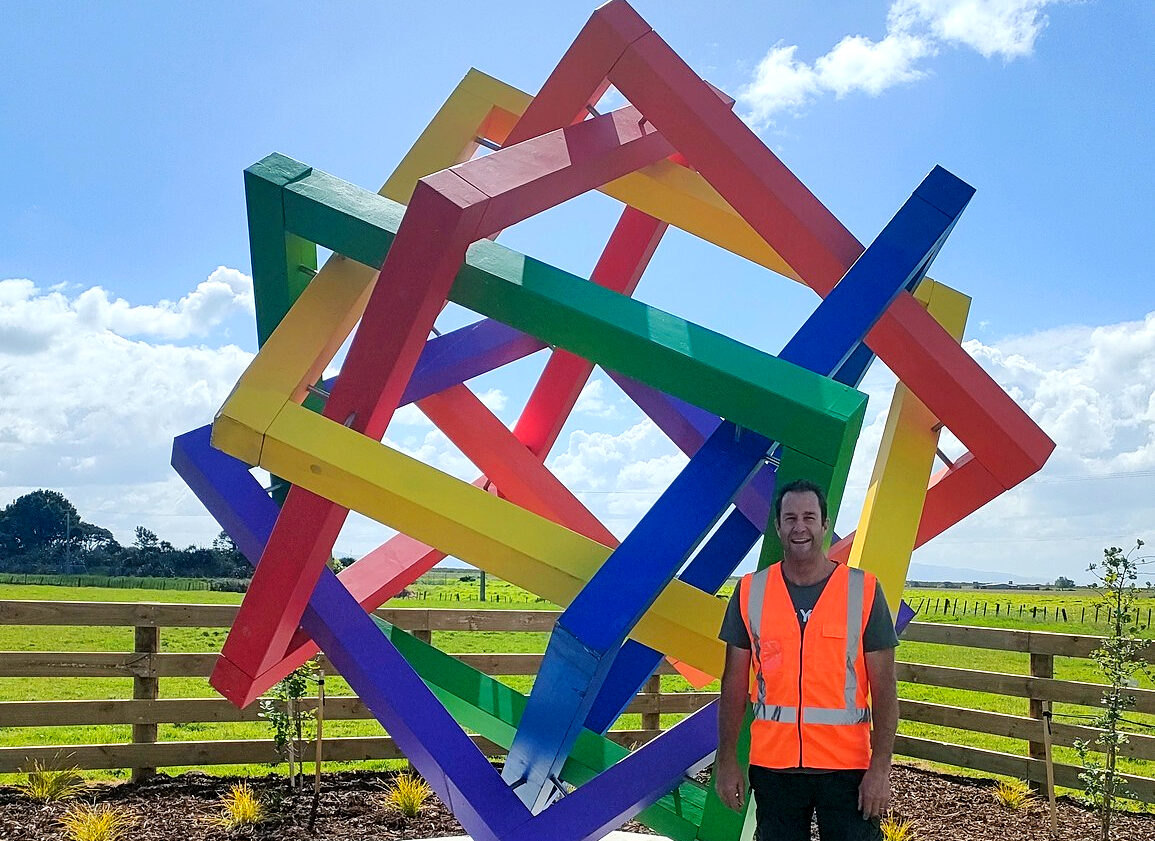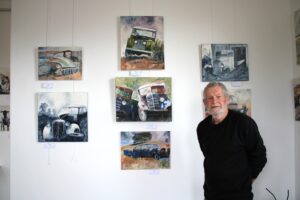Social media has tarnished the unveiling of a colourful new sculpture designed by late artist Chris Budgen, with two Thames community leaders now calling for users of online platforms to stop the spread of misinformation.
Chris’ sculpture – Interwoven – has been installed along the Ngati Maru Highway heading into Thames, and an opening event was held on December 2.
At the unveiling was Thames-Coromandel District Councillor Martin Rodley and Thames Community Board Member and Thames Public Art Trust trustee Rob Johnston.
Both have since become aware of negative comments on online Facebook pages, criticising the work for being “very rigid”, having “nothing to do with Thames” and being “a significant waste of money” despite it having no financial impact on ratepayers.
“I was at the opening and Isla [May Whinnen-Jensen] played music on the violin to acknowledge her friend Chris, who died a couple of years ago. I guess there was still the memory of that moment, and it was quite an emotional, special moment, and having that be degraded by some of the comments people were making wasn’t fantastic,” Martin told The Profile.
“I was a little sad, having known the history behind the sculpture, and so looking at it from my position and what I knew, and comparing that to the comments from people who clearly knew nothing about it and were just thinking it was a burden on the ratepayer… that made me think: ‘That’s really a shame people are putting those things out without knowing what was behind it’.”
Some of the comments Martin referred to accused Thames-Coromandel District Council of “wasting ratepayers money on crap”.
“It’s so not creative, a waste of ratepayers money again. Well done Thames,” said one poster.
“Colossal waste of resources,” said another.
“A ridiculous amount of taxpayer money for this ugly sculpture,” added one more.
But the council continued to remind commenters that it did not pay for the sculpture, and instead all credit must go to the Thames Public Art Trust and the “great cast of businesses and individuals” who volunteered time or money.
Interwoven would however require painting every few years, it said, with the Thames Community Board committing the $5,432 needed to maintain it as well as another upcoming sculpture, Miners’ Gates.
But there were other comments as well, with posters arguing that the colourful piece did not fit in with the aesthetic or history of Thames.
“This is an eyesore. It looks terrible. Surely more traditional art could have been put there, rather than this modernist stuff that will become outdated. Really doesn’t fit the area,” one said.
“I think it’s crap, [it] belongs in a kids play box. Real art are the great paintings around town,” said another.
“It really doesn’t fit with our image. Old worldly theme.”
“What [is that supposed to be], nothing to do with Thames, absolutely [waste of] money.”
TPAT trustee and community board member Rob Johnston said not every piece of art in Thames needed to reflect its history.
“That’s ridiculous,” he said. “There’s nothing wrong with acknowledging the past in certain ways, and there’s lots of ways of acknowledging it, but we’ve got a heap of it – what’s the problem with doing something new and interesting and different?
“Maybe [the commenters] would like to go back to horse and carriage? Maybe they’d like to go back to letter writing instead of sending emails? What about that?”
Rob said people posting online should remember that there was a person behind the art piece – and the person behind Interwoven was Chris Budgen, who passed away in January, 2019.
“When we had our competition, he came in with a model the size of a volleyball, and it was an entry that looked like something we could actually translate and scale up into a really big work,” Rob said. “He liked making those sorts of models and doing origami.
“[His partner] Saila Wood talked about how he would sometimes spend all day folding origami and if it went bad, he’d chuck it and start again. He liked his art and his music… he was an actual guy. He made an object we were able to turn into something large-scale and put out into the community, and Saila said he would’ve been over the moon to see it.”
Back in 2020, David McCracken’s ‘Baron’ sculpture – the one commonly described as “bomb-shaped” – was unveiled in the centre of Thames. The piece also received similar backlash with the art trust asking people at the time to have “open minds”.
Rob said he found it interesting that other pieces installed by the trust – such as the giant jandal, the horseshoe spheres, or the ‘hook’ at the Campbell St-Pollen St apex – had not received the same level of negativity.
“You could take out of that, that there’s an expectation of what people find inoffensive,” he said.
Both Rob and Martin agreed that while the internet could be useful, it often blurred the lines between “opinion versus fact” – with Rob saying it was “a constant surprise” to him how willing people were to “say stuff without thinking about it”.
But that wasn’t to say there weren’t any positive comments about the sculpture.
“This is awesome, brighten’s up our wee town,” one person said.
“Such a bright cheerful piece of art as you enter Thames,” added another.
“This is [in] a fantastic position and wow, what a sculpture,” said one more. “[I] saw some of the hard work out at Kopu. Well done all.”
‘Miners’ Gates’, a sculpture designed by Thames artist John McKeowen, will be the next public art piece to be installed; the timeframe of which is set for February, 2024.
BY KELLEY TANTAU





